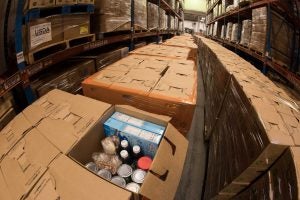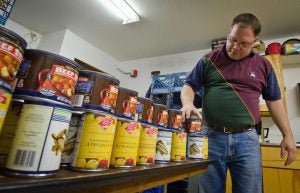When I started Brandywine Creek Farms — which was centered around the idea of turning our for-profit farm into an organization that donates produce to the feeding the food insecure in their community — some of my farming friends thought we were implying that farmers were not doing enough and more food needed to be produced. Nothing could be further from the truth. We began our nonprofit efforts of growing and donating produce after we noticed food banks and food pantries rarely had fresh fruits and vegetables. While that was true at the time, a lot of food banks got the message and started working hard to include fresh produce in their food procurement planning.
However, to this day I still get asked, “Why are farmers not growing enough food?”
To me, it’s a strange and misinformed question. As if farmers were not doing their part. My farm has a mission to improve access to fresh produce, not pick up the slack of other farmers. As a citizen of the United States, I am blessed to live in a country where farmers not only produce the healthiest and safest food on the planet, they actually over-produce it, so there is always abundance.
So the big-picture question is: If we, as farmers, are doing our part, why is there still a food problem in so many regions? Why are there individuals who are hungry?
There is no denying that hunger and food insecurity are real problems in the United States. Municipalities across the country are starting to focus on food deserts by appointing councils and tax incentives for grocery startups and urban gardens. But is that enough? Is the lack of food access in some areas the cause of hunger? It can certainly explain some food insecurity issues, but definitely not all of them. (Something I will explore at a later date is how rural food deserts often are ignored while urban food deserts seem to get most of the attention and resources.)
So when we plant a grocery store in a food desert, does hunger go away? According to a study in the Quarterly Journal of Economics, opening a grocery store in a food desert doesn’t have the effect on food insecurity that we all previously thought — or hoped. There is still hunger.
If there is one thing my work in affordable food access and hunger has taught me, it is that there is not one solution that is a catch-all cure for hunger. The COVID-19 pandemic has only added to an already burdened charitable network of food pantries. Food deserts are by far not the only cause of hunger. In the United States, pre COVID, we already had a large population that was dependent on food pantries and soup kitchens, and because of that, we have seen the charitable food organizations strained to their limit during the heights of the pandemic. I’ve noticed that multiple food pantries across the country have adopted the idea of providing food with no questions asked (some pantries have requirements in order to receive food). While on the surface that sounds like a wonderful idea to preserve the dignity of those whom the pantry serves, is that really the case?
Are we, as a society, interested in band aids or do we want cures?

We should ask ourselves: Why are individuals utilizing food pantries? Is it related to job loss? Yes. Income constrained due to outside factors? Yes. Unable to hold a job? YES.
A lot of my clients fall into that last category. The first two groups often rise out of the need for assistance, but the last one doesn’t. While desperately trying not to oversimplify a complex issue, food assistance is often temporary and instrumental during the transition from employed to unemployed and then employed again or while waiting for income to stabilize. The last category, and arguably the fastest growing, has become dependent on food assistance. If someone who we serve becomes a client of our services in May, we don’t want them utilizing our services in October with no improvement in their situation — if they are, then we have failed them.
That is why we ask questions. That is why we partner with a large network of services that can meet the needs we can’t. Food is the most basic necessity that we can meet immediately, and we can thank the American farmer for that. As far as getting them out of the cycle of poverty, that falls on multiple individuals and organizations using a wrap-around approach to treating the cause of hunger (job loss, addiction, formerly incarcerated, untreated mental health condition, etc.). Thanks to the American farmer, we can ease the hunger symptom while other resource organization administer the cure. For both churches and charities, food needs to be the bridge to resources, not a crutch that simply maintains existence.
It is important to catch as many people entering the cycle of poverty early, before dependence on the system sets in. Whether the driving force is a loss of income or mental health issue, it makes no difference; early intervention leads to getting out of the cycle faster. If we understand how many are on the edge of this cycle, we’ll realize it takes very little to push them over. The United Way defines this population as the A.L.I.C.E Population — an acronym that stands for Access Limited, Income Constrained, Employed. They earn more than the Federal Income Poverty Level, but for numerous reasons they are often a paycheck away from poverty.
In my work I have met several of these individuals and families — foreclosures, evictions, layoffs, and decreased work hours have all played into the tipping point for my clients. Even unplanned pregnancies can push an individual or family into the cycle.

The idea of providing food with no questions asked or necessary qualifications seems noble enough, and I completely understand the idea behind it, but would you hand an alcoholic $10 and say nothing? What if you handed them $10 with an offer to give them a ride to AA, followed by a sponsor who is there to talk them down from a relapse?
I’m in no way comparing someone who has hit a rough patch to someone who suffers from an addiction, which is a disease in and of itself. I’m talking about the numerous individuals who rely on food pantries and donations to meet their daily needs because of a lack of mental healthcare or little to no education, including financial literacy. The individuals who are not participating in the workforce, not because they are lazy, but because they have been brushed aside by society and need the embrace of a caring individual or organization who can walk them through the resources, until they can walk on their own. We need to break that cycle of dependence, which hunger and food insecurity is a symptom of, by treating the ailment that is the cycle of poverty.
If you read this and surmise that I am saying to stop giving away food to those in need, then you missed the entire point. Too many children are in situations they had no control over to be that callous. Too many people have no safety net. Taking away free food is not the answer either. Using food assistance as the beginning of the relationship that brings individuals and families out of the cycle of poverty is the entire point. American farmers are doing their part and have been for years. Handing someone a box of food might “fix” their immediate needs and make you feel better, but again, that is a band aid on a chest wound.
Addressing hunger with a continuous supply of “free” food while ignoring the root cause will guarantee one thing: There will always be an ever growing population of the hungry. Farmers already solved the hunger problem. Now we need other professions to join with us and offer their services on the front lines and make the same offer and sacrifices the American farmer does. That is the only way we will dramatically decrease the symptom of hunger in this country.
Jonathan Lawler operates Brandywine Creek Farms in Indiana and is an advocate for hunger relief and agriculture. He is working on a TV show called Punk Rock Farmer coming in the spring. His motto is FARM OR DIE.



